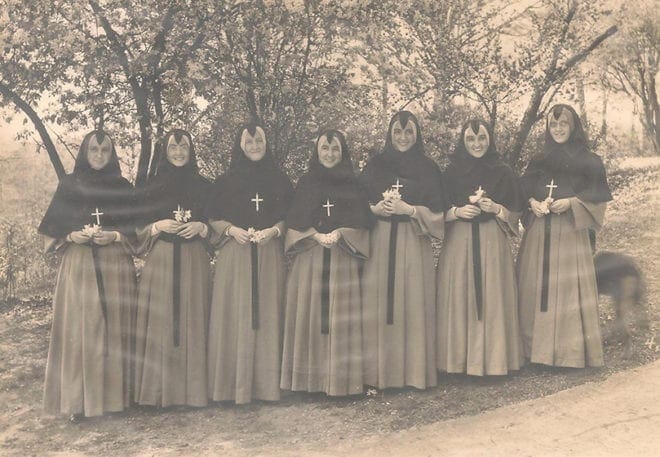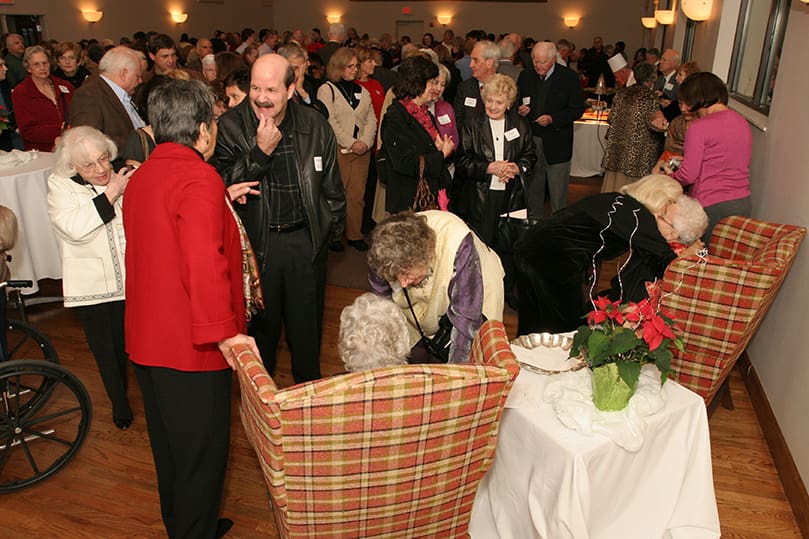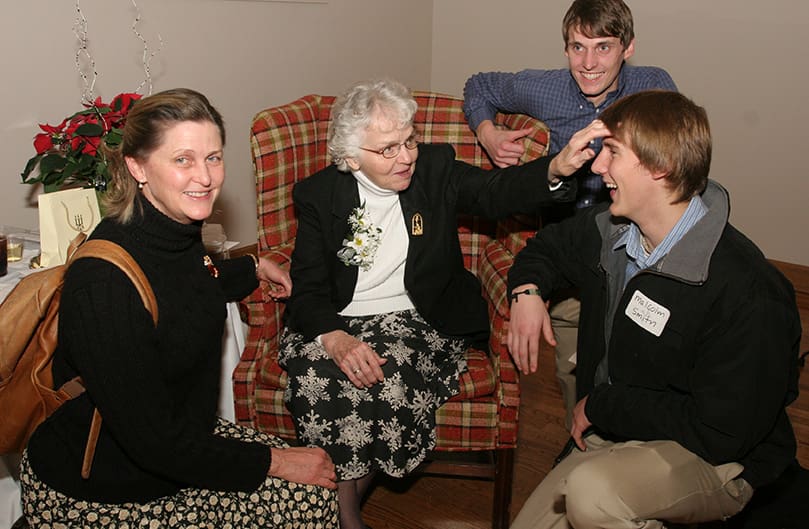The Grey Nuns of the Sacred Heart Sister Sally White, left, and Sister Eileen Murray receive a standing ovation from the congregation at St. Jude the Apostle Church, Atlanta, following Msgr. James Fennessy's homily. Photo By Michael Alexander
Yardley
Grey Nuns Remember 73 Years In North Georgia
By EILEEN DICKERSON, Special To The Bulletin | Published June 24, 2010
In the summer of 1937, five Grey Nuns of the Sacred Heart arrived in Atlanta at the invitation of Savannah Bishop Gerald O’Hara, who was responsible for all Catholics in Georgia.
He asked the sisters to help found Christ the King School, a new Catholic elementary school that would be nestled in an area where Catholicism was not yet very present or well understood.
In the spring of 2010, Sister Sally White, a native of Atlanta, became the last Grey Nun serving in active ministry in North Georgia, as she retired from her work at Saint Joseph’s Hospital in Atlanta and moved to the congregation’s motherhouse in Yardley, Pa.
In the 73 years between 1937 and 2010, 179 Grey Nuns have served in the archdiocese. They have taught children, founded and administered Catholic schools, nursed the sick, cared for the elderly, helped the homeless and needy, guided parishioners in ministry, welcomed immigrants, and brought the Eucharist to the ill and the homebound. As they ministered, they worked to impart Gospel values and promote ideas of peace and social justice.
Their years of service will be celebrated at a special Mass Sept. 1 at the Cathedral of Christ the King.
The sisters’ memories of their 73 years in Atlanta, drawn from archives at the motherhouse, are happy and colorful. The earliest describe the years before the Cathedral of Christ the King and school were completed. Masses and classes were held in the rectory—a former Ku Klux Klan administration building—and two grades were taught in one classroom.
The “convent” was two upper floors of an apartment building on East Wesley Road. The late Sister Marie Christine Fitzgerald, remembering those times, wrote, “We were leading a Spartan existence. Each of us had only one chair, which we took with us from room to room. I shared a room with Sister Mary Evangeline. We could not both get out of bed at the same time because the space between them was so narrow. Our food, though nourishing, had to be inexpensive because we had little money.”
The Cathedral and the school were eventually completed and, over the years, 126 Grey Nuns taught and administered there. The sisters went on to teach and be principals at other North Georgia Catholic schools: Immaculate Heart of Mary, St. Pius X High School, D’Youville Academy, St. Jude the Apostle, St. John Neumann and Archbishop Donnellan. Grey Nuns also served at St. Paul of the Cross School and at Holy Cross, Holy Family, St. Brendan and St. John the Evangelist parishes.
The transplanted sisters settled into their Southern home, acclimating to many new things, among them the city’s sweltering summer heat and the residents’ unfamiliarity with their religion and their garb. They endured the discomfort of wearing long underwear and heavy serge habits in the summer as well as the occasional description of them as “witches” by children they encountered in public places.
Nonetheless, the sisters loved the profusion of colorful flowers, the warmth and gentility of the people and the sweetness of their young students. In time, Atlanta became home.

The Grey Nuns who came to Atlanta in the early years include, left to right, Sister Mary Timothy Donahue, Sister Marie Christine Fitzgerald, Sister Mary Clement Groat (Superior), Sister Mary Dorothy Maroney, Sister Mary Regina Strauss, Sister Mary Evangeline O’Donoghue and Sister Margaret William O’Day. Photo Courtesy of the Grey Nuns of the Sacred Heart Archives
Sister Mary Charlotte Barton, principal of D’Youville Academy in the 1960s, recalls Atlanta’s lush physical beauty. “Cascading azaleas covered the hillside in front of the building—the former Fisher and then Lee estate—and led to a garden of roses and ponds below where class days were held and nature offered reflection on the glory of the Creator.”
Sister Cecilia Cosgrove, who taught at St. Pius High School in the early 1970s, agrees.
“I loved spring there,” she said. “It was so lovely it almost took your breath away. I often went outside at lunch and sat on the top row of the bleachers on the football field, just to take it all in.”
The beauty of the city was surpassed, the teaching sisters say, by the charm of their students.
“I was so impressed with the self-possession and maturity level of some of my 6-year olds,” remembered Sister Ann McKee.
“Warm, beautiful, gracious people and students who were bright, cheerful and fun to be with,” added Sister Patricia Eileen McKeon.
It wasn’t just the children who impressed the sisters.
“The parents were interested, involved, cooperative and generous to the sisters,” said Sister Helen Martin, who served at Christ the King School in the 1950s and ‘70s. “During my years there, an additional wing was added to the school and the beautiful convent built.”
Sister Anne Boyer remembered “the deep faith of the people.”
The sisters developed close personal relationships with the warm and friendly Georgians.
“Because many of us didn’t get to go home to visit often, we were welcomed into many family celebrations and holidays,” said Sister Dawn Gear, founding principal of St. John Neumann Regional Catholic School and the Donnellan School, now Holy Spirit Prep. “We became family and that feeling still exists today.”
Sister Patricia Geary, former teacher and associate superintendent of archdiocesan Catholic schools in the 1980s, observed, “Southern hospitality is not just a slogan. … It is the lived reality of the people of Atlanta.”

Sister Mary Raphael is shown with a student at D’Youville Academy, a Catholic secondary school opened by the Grey Nuns in Atlanta in 1960. The academy closed in June 1969 when the number of women religious teachers declined in number. Photo Courtesy of the Grey Nuns of the Sacred Heart Archives
Grey Nun ministries expanded over the decades into areas other than education. Sisters served at Catholic Social Services (the precursor to Catholic Charities Atlanta), in prison ministry, at Saint Joseph’s Hospital and Mercy Mobile Health Care, the St. Vincent de Paul Society, Marian Manor Catholic personal care home and other archdiocesan departments.
Sister Barbara Harrington, who worked in immigration services at Catholic Social Services, “witnessed the growth of the Hispanic presence and the Hispanic Apostolate in Atlanta, from its embryonic, zealous Cuban community to the pioneering Mexican families and then, the arrival of Central Americans due to the upset in their countries.”
Sister Kay Purser, an experienced Catholic school principal, said working at the St. Vincent de Paul Society “broadened and deepened my vision of society,” as she learned to drive a forklift and work in a warehouse.
Historic events in the Catholic Church and in the United States occurred during the sisters’ tenure: the Second Vatican Council, the assassinations of President Kennedy, Dr. Martin Luther King Jr. and Sen. Bobby Kennedy, and the Vietnam War and its accompanying protests.
“The spirit of Vatican II was very much alive due to the influence of Archbishops (Paul) Hallinan and (Thomas) Donnellan. It was … an alive place to be as a Catholic,” Sister Frances Whitman, who worked at the Metropolitan Tribunal, remembered.
Sister Rosalie Bertell, who was on the faculty of D’Youville Academy when Dr. King was assassinated, said she and her students watched the funeral together on television and talked about what they were witnessing.
“It was a very moving experience with an open discussion of racial prejudice,” she said.
“These years were formative for young people of the time and D’Youville Academy was a strong and influential factor in the lives of its young people,” added Sister Mary Charlotte. “They were supported by a faculty who challenged them to examine their spiritual, intellectual and human values in search of the truth.”
These are the gifts the Grey Nuns hope they gave to the archdiocese and the people of Atlanta: strong spiritual, human and intellectual values. In return, the sisters received love, loyalty, assistance and generosity, “a positive spirit that empowered us to build friendships, strive for excellence and deepen our life of faith,” said Sister Jean Liston, principal at Christ the King School from 1976 to 1988.
Sister Rose Mary Cauley perhaps best speaks for all of the Grey Nuns of the Sacred Heart: “Never have I been so warmly welcomed and that feeling has carried me through many years. My ministry in Atlanta was a gift, wrapped in many blessings.”
Eileen Dickerson is director of development for the Grey Nuns of the Sacred Heart at their motherhouse in Yardley, Pa.



